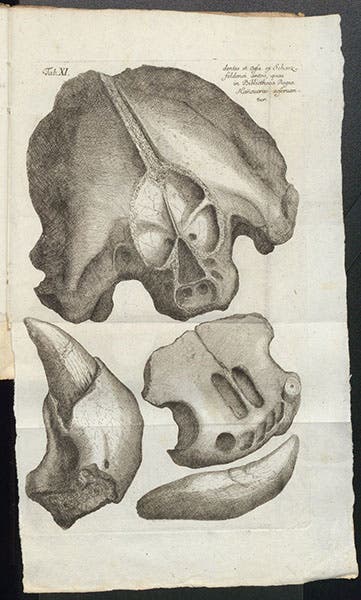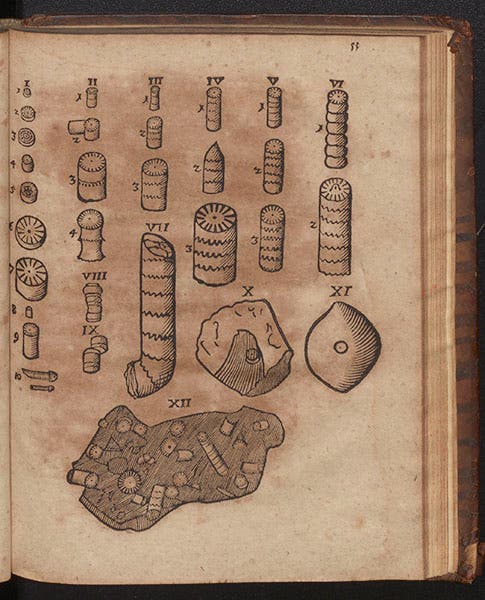Scientist of the Day - Gottfried Wilhelm Leibniz
Gottfried Wilhelm Leibniz, a German philosopher, mathematician, and geologist, was born July 1, 1646, in Leipzig, Germany. Two years ago on this date, George Gale wrote a post for us on Leibniz in which he focused primarily on Leibniz's considerable mathematical abilities, and his invention of a mechanical calculator. Today, we are going to look at Leibniz’s study of geology and fossils, which was just as insightful as his work in philosophy and mathematics, but far less appreciated.
In the late 17th century, a new scientific genre sprang into being, called by its practitioners: "Theories of the Earth." It had its origins in the work of René Descartes, who in his Principles of Philosophy (1644) proposed that the earth had originated from a cooling star, which crusted over, cooled, and cracked, allowing water vapor and gases to escape, with the result that the crust collapsed, forming mountains and ocean basins that soon filled with the escaped water. As a scenario, it was ingenious, plausible, and lacking any overt reference to the creation account in Genesis. In 1681, an English cleric, Thomas Burnet, adopted the Cartesian mechanical approach to the question of the origin of the Earth, but attempted to bring Genesis back in, arguing that (in Burnet's opinion), the scriptural account was identical to the mechanical account, so that you did not need miracles at any step of the way. God just watched it all unfurl.
Burnet's book prompted dozens of attacks, rejoinders, and alternative proposals, and the debate over the Earth’s origin would rage until James Hutton wrote the definitive Theory of the Earth in 1795. We did an exhibit once called Theories of the Earth (1984), in which we displayed some fifty different theories of the earth (including those of Descartes and Burnet).
Just after Descartes, fossils entered geology, with the demonstration by Nicolaus Steno and Robert Hooke, that fossils are organic remains that were deposited in the Earth long ago, and which, like Roman coins and inscriptions, can be used to shed light on history, in this case, the history of the Earth. Most authors of theories of the Earth paid no attention to fossils. It was Leibniz who would fuse the two genres.
Leibniz, who spun off ideas the way other people perspire, had the notion in the 1680s that he could power the mines of the Harz Mountains with windmills, and he spent a great deal of time in the mines, trying to make it work. He thus became intimately acquainted with mines, caves, the Earth, and fossils, and unlike most other people, he gave some thought to what it all meant. The outcome was a book manuscript, Protogaea, completed around 1693.
In his book, Leibniz essentially followed the Cartesian hot-Earth scenario, but with much more detail. He pointed out that when rock cools from a molten state, it forms blisters and air pockets, which make subterranean caverns when they cool, and which, he noted, would take a very long time. He brought fossils into the picture, pointing out that in large caves like Baumann’s cave in the Harz district, there are many fossil bones, some from animals which do not look like present-day species (first image). He agreed with Steno that glossopetrae, very common fossils, are fossilized sharks’ teeth, and their presence in Germany indicates that large seas once covered the area (fourth image). He even copied the shark’s head that had appeared in Steno’s dissertation on glossopetra (1667), which Steno had in turn copied from a manuscript of Michelle Mercati (fifth image).
Had Leibniz published his book in 1693, it would no doubt have had a considerable influence on succeeding theories of the Earth, especially since most of them until 1749 were flood theories that downplayed the role of heat in forming the Earth. He did publish a very short abstract in the Acta Eruditorum in 1693, but it really gave no scope of the detail in his extended treatise. The book was eventually put into final form and published by Christian Ludwig Scheidt in 1749, the same year that Georges Buffon published his own theory of the earth, which, like Leibniz’s, had the earth forming from a large molten mass and cooling over a extended period of time. Scholars think that Buffon probably knew about the contents of Leibniz’s Protogaea, although he had not seen the manuscript.
The Protogaea as published had 12 engraved plates. Some, like the section of Bauman’s cave, were original, and were probably commissioned by Leibniz himself. But six of them were taken directly from woodcuts in the Oryktographia Hildesheimensis of Friedrich Lachmund, published in 1669; the borrowing was probably made by Scheidt. We include here the engraving in the Protogaea of fossil crinoids, and the woodcut in Lachmund’s book from which it was copied (seventh and eighth images). One should never assume that any illustration in an early modern book is original, since many images, especially the really good ones like Steno’s shark, were passed from publication to publication within any credit being given.
Leibniz’s Protogaea may have had little influence on geology for 56 years. But once published, it had a great impact on theories of the Earth after Buffon, as more and more theorists began to adopt the hot-Earth scenario laid out by Leibniz.
William B. Ashworth, Jr., Consultant for the History of Science, Linda Hall Library and Associate Professor emeritus, Department of History, University of Missouri-Kansas City. Comments or corrections are welcome; please direct to ashworthw@umkc.edu.














